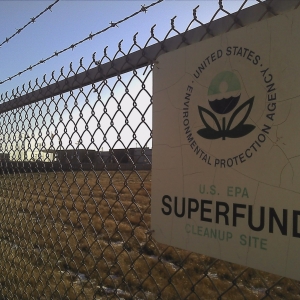Federal Water Tap, December 2: GAO Finds Military Water Risk Assessments Deficient
The Rundown
The Defense Department does not use consistent methods to evaluate water scarcity risk at its bases, a GAO report finds. A PFAS health study lags in bureaucratic limbo. A federal judge defers to the EPA on whether the Clean Water Act covers groundwater pollution connected to surface waters. Cabinet officials support a tribal water rights settlement in Montana. The USGS investigates Pecos River salinity. The EPA solicits public comments before it develops a reporting requirement for industrial releases of PFAS chemicals. The EPA is slow to implement water program improvements that were offered by its internal watchdog. And lastly, the Bureau of Reclamation will evaluate subsidence-related canal repairs in California’s Central Valley.
“I think we have to bring clarity to the situation, and I also think that these kinds of settlements, these kinds of complicated problems, are best done through this negotiation process.” — William Barr, U.S. attorney general, discussing the merits of a water rights settlement with the Confederated Salish and Kootenai Tribes, according to the Missoulian newspaper. The settlement, which has been approved by Montana, awaits endorsement from Congress and tribal government. If the settlement is not approved, individual water rights claims would have to be worked out in court.
In context: In Drying Colorado River Basin, Indian Tribes Are Water Dealmakers
By the Numbers
5: Recommendations for improving the performance of its water programs that the EPA has not yet implemented. Those recommendations relate to oversight of state drinking water and pollution permitting programs, as well as communicating to vulnerable populations the risks of eating contaminated fish. Some of these recommendations were made nine years ago. (Office of the Inspector General)News Briefs
PFAS Study Delay
Bureaucratic entanglements are slowing a federal study into the health effects of PFAS chemicals in drinking water, USA Today reports.
Congress set aside $10 million last year for the study, which will examine chemical exposures and health outcomes stemming from contaminated sites in seven states. The sites were announced in September and the Centers for Disease Control and Prevention is designing a study that will involve 6,000 adults and 2,000 children.
The delay is due to misunderstanding between the CDC and the White House Office of Management and Budget about the timeline for starting the study, according to people familiar with the discussions.
Groundwater Pollution and Clean Water Act
A U.S district court in Massachusetts said that it would defer to the U.S. Environmental Protection Agency’s recent determination that pollution discharges to groundwater that is connected to surface water does not require a federal permit.
That ruling came from a case involving a wastewater treatment facility on Cape Cod, Bloomberg reports.
This is a hotly contested issue. Because federal appeals courts have reached contradictory rulings, the U.S. Supreme Court decided to weigh in, agreeing to take on a case from Maui. Oral arguments in that case happened on November 6.
California Canal Repair
A 33-mile section of the Friant-Kern canal, in California’s Central Valley, has lost more than half its transport capacity because of structural failures. The federally owned canal, which delivers irrigation water to Kern and Tulare counties, is slumping because the ground is sinking. The ground is sinking because too much groundwater has been pumped, largely by irrigators.
The Bureau of Reclamation will prepare an environmental impact statement to assess two options for repairing the canal. The first option would enlarge and raise the entire damaged section. The other would construct a new 23-mile canal section, in addition to enlarging and raising the remaining 10 miles.
A public meeting will be held on December 18 in Porterville, California. Comments on the scope of the review should be emailed to remerson@usbr.gov.
In context: Surviving the Next Drought: It’s Political in California’s Central Valley
Studies and Reports
Counting Military Bases At Risk of Water Scarcity
The Defense Department is not using consistent approaches when assessing water scarcity risks for its bases, according to a Government Accountability Office report.
The findings raise questions about the quality of the assessments and reliability of the information, the watchdog agency’s report states.
The GAO based its audit on a review of six Defense Department water risk assessments that were completed since April 2017. Three studies conducted by the Office of the Secretary of Defense did not use generally accepted best practices for evaluating water risk, the GAO found. The other three studies were conducted by individual military branches and are not applicable across the department, Defense officials said.
Combined, the studies pointed to water supply vulnerabilities at 102 military installations. But only one installation — Vandenberg Air Force Base, in Santa Barbara County, California — appeared in all three OSD assessments.
The GAO recommended that Defense officials evaluate whether a department-wide assessment is needed. The department agreed with the recommendation.
Besides drinking water and sanitation, bases need water for training activities, missile testing, fire suppression, and rocket launching.
The report was requested by Congress as part of a Defense spending authorization bill.
Salinity in Pecos River
U.S. Geological Survey researchers found two stretches of the Pecos River where salt concentrations in the water are notably increasing. Those stretches are in southeastern New Mexico, between Acme and Artesia, and in western Texas between Orla and Grandfalls.
Salinity levels in the river just south of Grandfalls reached a peak of 16,000 milligrams per liter, or roughly half as salty as the ocean.
The sources of the salts are both natural (groundwater discharge) and manmade (irrigation runoff). The river is not directly used as a drinking water source. But it does feed into a reservoir that provides municipal water.
The river also provides habitat for wildlife and water for livestock and irrigation. High salinity — above 3,000 milligrams per liter — can cause problems. It can render the water unusable even for animals and crops.
On the Radar
PFAS Reporting Proposal
The U.S. Environmental Protection Agency gave notice that it will seek public comments as it develops a rule to require companies to report releases of certain PFAS chemicals.
The notice concerns the Toxics Release Inventory, which is clearinghouse for companies to report annual discharges of listed compounds.
The agency wants input on several topics: Which of the thousands of PFAS chemicals should companies be required to report? Releases above what amount should trigger the reporting requirement? The agency says it is considering lower reporting thresholds than usual because PFAS chemicals accumulate in bodies and do not break down in the environment.
The move to update reporting requirements is the agency’s first major action under its PFAS action plan, which was released in February.
Submit comments via www.regulations.gov using docket number EPA-HQ-TRI-2019-0375.
Endangered Species and Natural Gas Plant
A Pennsylvania power plant that draws cooling water from the Delaware River will tailor its operating practices to reduce the likelihood of killing or otherwise harming two endangered sturgeon species, according to a draft environmental impact statement released by the National Marine Fisheries Service.
Eddystone Generating Station will minimize the use of cooling water intakes. The intakes draw water from the Delaware and can trap the shortnose and Atlantic sturgeon.
Comments on the proposal are being accepted through January 2. Submit them via www.regulations.gov using docket number NOAA-NMFS-2019-0076.
Federal Water Tap is a weekly digest spotting trends in U.S. government water policy. To get more water news, follow Circle of Blue on Twitter and sign up for our newsletter.
Brett writes about agriculture, energy, infrastructure, and the politics and economics of water in the United States. He also writes the Federal Water Tap, Circle of Blue’s weekly digest of U.S. government water news. He is the winner of two Society of Environmental Journalists reporting awards, one of the top honors in American environmental journalism: first place for explanatory reporting for a series on septic system pollution in the United States(2016) and third place for beat reporting in a small market (2014). He received the Sierra Club’s Distinguished Service Award in 2018. Brett lives in Seattle, where he hikes the mountains and bakes pies. Contact Brett Walton






Leave a Reply
Want to join the discussion?Feel free to contribute!